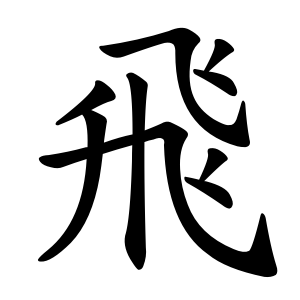飛
- flying, to fly;
Etymology
The character 飛 is a pictograph based on the image of a bird in flight. It imitates the shape of a bird flapping its wings as it takes off.
Originally, the character 非 (아닐 비), which also resembles outstretched wings, was used to represent the idea of flying. However, 非 later became reassigned (through phonetic borrowing) to mean “not” or “wrong”, and a new character, 飛, was created to retain the original meaning of "to fly."
Due to its complexity, simplified forms of 飛 were developed:
One such form is 𠃧 (U+200E7), written as ⿱飞飞, a structure where two simplified wings are stacked.
An even further simplification resulted in just the first three strokes, becoming 飞, the official simplified character used in Mainland China.
In contrast:
Japan’s shinjitai (new character forms) retains the original full form 飛.
Korea and Taiwan also continue to use the traditional character 飛.
Usage in Korean
It is used in various contexts related to flight or swift movement, such as:
飛行 (비행) – flight, flying
飛鳥 (비조) – flying bird
飛散 (비산) – scattering or flying apart
When used as a semantic radical, it conveys meanings related to flying or soaring through the air.
Examples:
飜 (번) – to translate (originally meant to turn over or flip, related to flight)
飝 (비) – to fly (an emphatic or intensified form of 飛)
䬡 (저) – to soar upward or fly up
These characters share the 飛 radical and relate to various aspects of flight, movement in the air, or elevation.
Characters with 飛
- 弓人竹廿人 (NOHTO)
- ⿻ 𠃧 ⿰⿱ 丿 丿 丨
